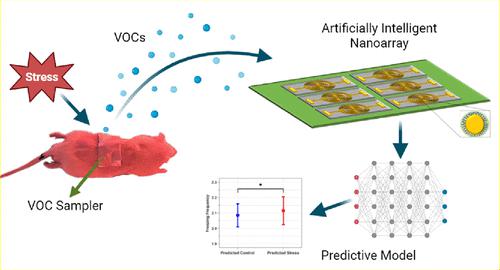Our official English website, www.x-mol.net, welcomes your feedback! (Note: you will need to create a separate account there.)
Noninvasive Detection of Stress by Biochemical Profiles from the Skin
ACS Sensors ( IF 8.9 ) Pub Date : 2023-02-27 , DOI: 10.1021/acssensors.3c00011 Elias Mansour 1 , Eilam Palzur 2 , Yoav Y Broza 1 , Walaa Saliba 1 , Sharon Kaisari 3 , Pavel Goldstein 3 , Alon Shamir 4, 5 , Hossam Haick 1, 6
ACS Sensors ( IF 8.9 ) Pub Date : 2023-02-27 , DOI: 10.1021/acssensors.3c00011 Elias Mansour 1 , Eilam Palzur 2 , Yoav Y Broza 1 , Walaa Saliba 1 , Sharon Kaisari 3 , Pavel Goldstein 3 , Alon Shamir 4, 5 , Hossam Haick 1, 6
Affiliation

|
Stress is a leading cause of several disease types, yet it is underdiagnosed as current diagnostic methods are mainly based on self-reporting and interviews that are highly subjective, inaccurate, and unsuitable for monitoring. Although some physiological measurements exist (e.g., heart rate variability and cortisol), there are no reliable biological tests that quantify the amount of stress and monitor it in real time. In this article, we report a novel way to measure stress quickly, noninvasively, and accurately. The overall detection approach is based on measuring volatile organic compounds (VOCs) emitted from the skin in response to stress. Sprague Dawley male rats (n = 16) were exposed to underwater trauma. Sixteen naive rats served as a control group (n = 16). VOCs were measured before, during, and after induction of the traumatic event, by gas chromatography linked with mass spectrometry determination and quantification, and an artificially intelligent nanoarray for easy, inexpensive, and portable sensing of the VOCs. An elevated plus maze during and after the induction of stress was used to evaluate the stress response of the rats, and machine learning was used for the development and validation of a computational stress model at each time point. A logistic model classifier with stepwise selection yielded a 66–88% accuracy in detecting stress with a single VOC (2-hydroxy-2-methyl-propanoic acid), and an SVM (support vector machine) model showed a 66–72% accuracy in detecting stress with the artificially intelligent nanoarray. The current study highlights the potential of VOCs as a noninvasive, automatic, and real-time stress predictor for mental health.
中文翻译:

通过皮肤的生化特征无创检测压力
压力是多种疾病类型的主要原因,但由于目前的诊断方法主要基于高度主观、不准确且不适合监测的自我报告和访谈,因此未得到充分诊断。虽然存在一些生理测量(例如,心率变异性和皮质醇),但没有可靠的生物测试来量化压力的大小并实时监控它。在本文中,我们报告了一种快速、无创且准确地测量压力的新方法。整体检测方法基于测量皮肤响应压力而释放的挥发性有机化合物 (VOC)。Sprague Dawley 雄性大鼠(n = 16)暴露于水下创伤。16 只幼稚大鼠作为对照组(n= 16). 在创伤事件发生之前、期间和之后,通过与质谱测定和量化相关的气相色谱法,以及用于简单、廉价和便携式检测 VOC 的人工智能纳米阵列,对 VOC 进行了测量。在诱导压力期间和之后使用高架十字迷宫来评估大鼠的压力反应,并使用机器学习来开发和验证每个时间点的计算压力模型。具有逐步选择的逻辑模型分类器在使用单一 VOC(2-羟基-2-甲基丙酸)检测压力时产生了 66-88% 的准确度,而 SVM(支持向量机)模型显示出 66-72% 的准确度用人工智能纳米阵列检测压力。目前的研究强调了挥发性有机化合物作为一种无创、
更新日期:2023-02-27
中文翻译:

通过皮肤的生化特征无创检测压力
压力是多种疾病类型的主要原因,但由于目前的诊断方法主要基于高度主观、不准确且不适合监测的自我报告和访谈,因此未得到充分诊断。虽然存在一些生理测量(例如,心率变异性和皮质醇),但没有可靠的生物测试来量化压力的大小并实时监控它。在本文中,我们报告了一种快速、无创且准确地测量压力的新方法。整体检测方法基于测量皮肤响应压力而释放的挥发性有机化合物 (VOC)。Sprague Dawley 雄性大鼠(n = 16)暴露于水下创伤。16 只幼稚大鼠作为对照组(n= 16). 在创伤事件发生之前、期间和之后,通过与质谱测定和量化相关的气相色谱法,以及用于简单、廉价和便携式检测 VOC 的人工智能纳米阵列,对 VOC 进行了测量。在诱导压力期间和之后使用高架十字迷宫来评估大鼠的压力反应,并使用机器学习来开发和验证每个时间点的计算压力模型。具有逐步选择的逻辑模型分类器在使用单一 VOC(2-羟基-2-甲基丙酸)检测压力时产生了 66-88% 的准确度,而 SVM(支持向量机)模型显示出 66-72% 的准确度用人工智能纳米阵列检测压力。目前的研究强调了挥发性有机化合物作为一种无创、


























 京公网安备 11010802027423号
京公网安备 11010802027423号